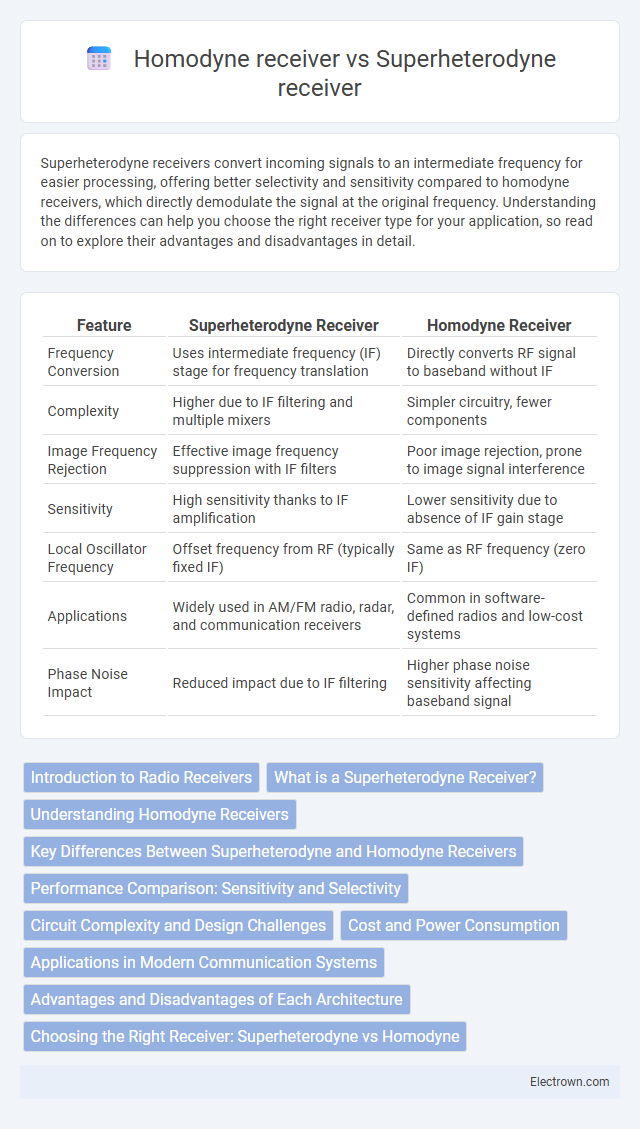Superheterodyne receivers convert incoming signals to an intermediate frequency for easier processing, offering better selectivity and sensitivity compared to homodyne receivers, which directly demodulate the signal at the original frequency. Understanding the differences can help you choose the right receiver type for your application, so read on to explore their advantages and disadvantages in detail.
Table of Comparison
| Feature | Superheterodyne Receiver | Homodyne Receiver |
|---|---|---|
| Frequency Conversion | Uses intermediate frequency (IF) stage for frequency translation | Directly converts RF signal to baseband without IF |
| Complexity | Higher due to IF filtering and multiple mixers | Simpler circuitry, fewer components |
| Image Frequency Rejection | Effective image frequency suppression with IF filters | Poor image rejection, prone to image signal interference |
| Sensitivity | High sensitivity thanks to IF amplification | Lower sensitivity due to absence of IF gain stage |
| Local Oscillator Frequency | Offset frequency from RF (typically fixed IF) | Same as RF frequency (zero IF) |
| Applications | Widely used in AM/FM radio, radar, and communication receivers | Common in software-defined radios and low-cost systems |
| Phase Noise Impact | Reduced impact due to IF filtering | Higher phase noise sensitivity affecting baseband signal |
Introduction to Radio Receivers
Superheterodyne receivers convert incoming radio frequency signals to an intermediate frequency, enhancing selectivity and sensitivity for clearer signal processing. Homodyne receivers directly convert the received signal to baseband without an intermediate frequency stage, simplifying design but often facing challenges with direct current offsets and phase noise. These foundational differences influence their applications in modern radio communication systems, balancing complexity and performance requirements.
What is a Superheterodyne Receiver?
A Superheterodyne receiver is a radio receiver that converts the incoming radio frequency signal to a fixed intermediate frequency (IF) using a mixer and a local oscillator. This frequency conversion improves selectivity and sensitivity by allowing consistent and optimized filtering at the IF stage. Your ability to receive weak or distant signals is enhanced due to the superior noise performance and stability offered by the superheterodyne architecture.
Understanding Homodyne Receivers
Homodyne receivers directly convert the received signal to baseband by mixing it with a local oscillator at the same frequency, offering simpler architecture and lower power consumption compared to superheterodyne receivers. These receivers are ideal for applications requiring minimal signal processing delay and reduced hardware complexity, such as in software-defined radios and low-cost communication devices. Your choice depends on the trade-offs between homodyne's simplicity and the superior selectivity and sensitivity provided by superheterodyne designs.
Key Differences Between Superheterodyne and Homodyne Receivers
Superheterodyne receivers convert the input signal to a fixed intermediate frequency (IF) using a local oscillator and mixer, enabling selective filtering and improved signal sensitivity. Homodyne receivers directly convert the input signal to baseband by mixing it with a local oscillator at the same frequency, simplifying circuit design and reducing component count. The key difference lies in frequency conversion: superheterodyne uses an intermediate frequency for better selectivity and stability, while homodyne offers simpler architecture with potentially reduced signal distortion at baseband.
Performance Comparison: Sensitivity and Selectivity
Superheterodyne receivers typically offer superior sensitivity and selectivity compared to homodyne receivers due to their use of intermediate frequency (IF) stages that allow better filtering and amplification. Homodyne receivers, while simpler and more compact, often face challenges with sensitivity because of direct conversion and issues like DC offset and flicker noise. Your choice between these architectures will impact the receiver's performance, especially in demanding signal environments where strong adjacent channel rejection and low-noise amplification are critical.
Circuit Complexity and Design Challenges
Superheterodyne receivers exhibit higher circuit complexity due to multiple frequency conversion stages and the need for stable local oscillators, resulting in intricate filtering and shielding requirements. Homodyne receivers feature simpler designs by directly converting RF signals to baseband, reducing component count and easing integration challenges, but suffer from issues like DC offset and LO leakage. Choosing the right architecture impacts your design approach, with superheterodyne offering superior selectivity at the cost of complexity, while homodyne provides simplicity with demanding calibration and signal processing needs.
Cost and Power Consumption
Superheterodyne receivers typically have higher cost and power consumption due to their complex architecture involving multiple frequency conversions and filters. Homodyne receivers offer a cost-effective and power-efficient alternative by directly converting the received signal to baseband without intermediate frequency stages. Your choice depends on balancing the need for sensitivity and selectivity against budget constraints and device power limitations.
Applications in Modern Communication Systems
Superheterodyne receivers dominate in modern communication systems such as cellular networks and radar due to their superior selectivity and sensitivity, enabling efficient signal processing across diverse frequency bands. Homodyne receivers find applications in software-defined radios and low-power wireless devices where simplicity and reduced component count are critical, facilitating direct conversion of RF signals to baseband with minimal distortion. Both receiver types play essential roles in technologies like 5G, satellite communications, and IoT networks, balancing performance and complexity based on specific system requirements.
Advantages and Disadvantages of Each Architecture
Superheterodyne receivers offer superior selectivity and sensitivity by converting incoming signals to a fixed intermediate frequency, enabling easier filtering and amplification, but they suffer from increased complexity, cost, and potential image frequency interference. Homodyne receivers simplify design by directly converting RF signals to baseband without an intermediate frequency, reducing size and power consumption, yet they face challenges with DC offsets, I/Q imbalance, and limited dynamic range. Selecting between architectures depends on application-specific requirements for performance, cost, and complexity trade-offs.
Choosing the Right Receiver: Superheterodyne vs Homodyne
Superheterodyne receivers excel in selectivity and sensitivity by converting signals to an intermediate frequency for easier filtering, making them ideal for applications requiring high-performance signal processing. Homodyne receivers offer simpler design and lower power consumption by directly converting the incoming signal to baseband, suitable for compact, low-cost wireless devices. Selecting between superheterodyne and homodyne depends on specific needs like complexity, cost, sensitivity, and battery life in wireless communication systems.
Superheterodyne vs Homodyne receiver Infographic

 electrown.com
electrown.com